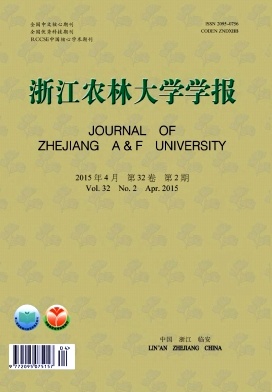Extraction methods for mycoprotein, a yeast-like symbiote isolated from brown planthopper, Nilaparvata lugens, in rice
doi: 10.11833/j.issn.2095-0756.2015.02.002
- Received Date: 2014-06-14
- Rev Recd Date: 2014-09-15
- Publish Date: 2015-04-20
-
Key words:
- plant protection /
- Nilaparvata lugens /
- yeast-like symbiote /
- mycoprotein /
- extraction method
Abstract: To select the most suitable cell breaking method for protein extraction of the yeast-like symbiote (YLS) isolated from brown planthopper, Nilaparvata lugens, three cell breaking methods: ultrasonication, repeated freeze-thaw, and liquid nitrogen grinding, were used to extract the mycoprotein of susceptible- and resistant-imidacloprid strains of YLS. Analysis was conducted by Duncans new multiple range test (DMRT) and sodium dodecyl sulfatepolyacrylamide gel electrophoresis (SDS-PAGE). Results of observation using cell microscopic morphology showed that the breaking effect of the YLS cells treated with ultrasonication and liquid nitrogen grinding were greater than repeated freeze-thaw. After treatment, cells were uniformly distributed and thoroughly broken. Optimum culture time for mycoprotein extraction was 72 h. Protein concentration for the three methods was significantly different (fd=8, P<0.05) with ultrasonication highest, then liquid nitrogen grinding, and lastly repeated freeze-thaw. After being cultured for 72 h, protein concentrations for the susceptible strain were ultrasonication, 2.82 gL-1; liquid nitrogen grinding, 2.62 gL-1; and repeated freeze-thaw, 2.12 gL-1; protein concentrations for the resistant strain were ultrasonication, 2.64 gL-1; liquid nitrogen grinding, 2.53 gL-1; and repeated freeze-thaw, 2.05 gL-1. Electrophoresis showed that proteins extracted by ultrasonication had clear bands, greater abundance, and more protein; by liquid nitrogen grinding had partial protein degradation and unclear bands; and by repeated freeze-thaw had the least protein. Thus, the ultrasonication method was best for mycoprotein extraction of YLS from N. lugens, and in the future this will provide technical support for two dimensional electrophoresis protein experiments and separation of differential proteins. [Ch, 4 fig. 1 tab. 22 ref.]
| Citation: | ZHANG Haiqiang, CHEN Jianming, ZHANG Juefeng. Extraction methods for mycoprotein, a yeast-like symbiote isolated from brown planthopper, Nilaparvata lugens, in rice[J]. Journal of Zhejiang A&F University, 2015, 32(2): 173-180. doi: 10.11833/j.issn.2095-0756.2015.02.002 |






 DownLoad:
DownLoad: